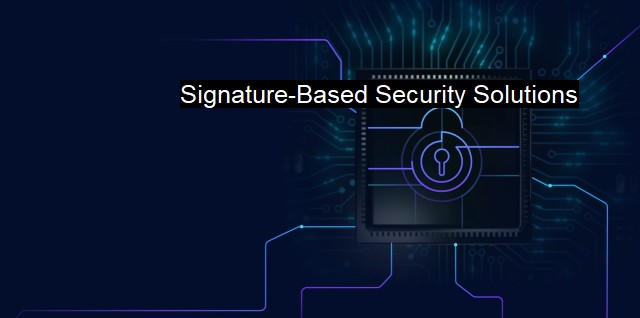What are Signature-Based Security Solutions?
The Importance of Signature-Based Security Solutions in Cybersecurity: Understanding the Technology, Advantages, and Limitations
Signature-based security solutions represent one of the primary types of defenses when dealing with cyber threats. They form a part of the wider landscape of cybersecurity and antivirus solutions employed in various deployment contexts, from individual consumer systems to enterprise-level technology systems. Since cyber threats have fast become an integral part of the digital world, the relevance of signature-based security solutions calls for deeper exploration, largely given its roles in alleviating the harsh impacts of digital threats.To properly fathom the concept, one must first grasp what signatures are in cybersecurity. A signature refers to a distinct pattern of malicious behavior or a series of bytes identifiable within a tunnel of traffic or within a file. Unique signatures often identify different kinds of malicious activities such as viruses, spyware, worms, or even specific kinds of hacking approaches employed by cybercriminals.
Signature-based security solutions then operate based on a database containing known malware such as spyware, Trojans, worms, and viruses. these security tools search strings of code against their database of known malware signatures. Every time there's a match, the system alerts the user about potentially harmful software or automatically isolates it to prevent further infection.
The effectiveness of these solutions lies within their scope and breadth to recognize and prevent known threats without taxing computational resources excessively. Known threats comprise a significant portion of daily cyber attacks. Therefore, the applications of signature-based security extend to organizations of all scales, consumer-grade antivirus, and intrusion prevention systems. Often they form part of a comprehensive threat prevention strategy, interlinking with other measures like behavior-based detection and anomaly detection.
Signature-based methods have some drawbacks, the chief of which is their inability to cope with the dynamism and agile nature of the software security threat landscape. A quintessential limitation is dealing with zero-day threats – network threats that exploit unknown computer security vulnerabilities. If a threat variant isn't in the malware signature database, the system will fail to notice it because the signature-based method inherently derives from knowledge of past threats.
Nonetheless, ongoing developments in virus signatures, like generic or heuristic signatures, extend address range and applicability. Heuristic signatures identify a harmful behavior or a series of harmful activities, providing a protective blanket against broader attack types that exhibit similar behaviors. This proves to be an advantage, especially against polymorphic viruses that undergo structural shifts to evade detection.
Signature-based security solutions also offer reliability and simplicity in design, allowing for low-latency high-speed operations. As they require only minimal data processing and do not typically generate a significant amount of network overheard, they are ideal for high-traffic environments. these solutions are a mature technology, having been employed for several years now.
Continuous development and updates are integral within signature-based security. Administrators must ensure that signature definition databases are regularly updated to account for new viruses and other emerging cyber threats. Many vendors cater to these aspects and offer automatic updates to encourage a smooth user experience and effective security.
To wrap up, it is catalytic to note that signature-based security solutions are efficient frontline defenses against known threats. given their limitations against novel cyber threats, they always function better as a part of multi-level defense mechanisms, combining well with behavioral and anomaly detection-based strategies. The world of cybersecurity calls for versatile protective measures, and traditional signature-based security solutions will always remain a mainstay in the industry.

Signature-Based Security Solutions FAQs
What is a signature-based security solution?
A signature-based security solution is a type of cybersecurity technology that identifies malware and other threats based on known patterns or "signatures." This technology scans files and systems to match against a database of previously identified threats.How effective is a signature-based security solution?
Signature-based security solutions are effective against known threats with established signatures. However, they may not be as effective against new, unknown threats that do not have a recognized signature.What are the limitations of signature-based security solutions?
The limitations of signature-based security solutions include the fact that they only detect threats based on known signatures. If a new malicious threat is developed, it may not be detected by the solution until it is added to the signature database. Additionally, attackers may use tactics such as polymorphism to change the appearance of a threat and evade detection by signature-based solutions.How does a signature-based security solution compare to other types of cybersecurity technologies?
Compared to other types of cybersecurity technologies, such as behavior-based detection and artificial intelligence/machine learning-based detection, signature-based solutions are often less effective in detecting new and unknown threats. However, they can still be a valuable component of an overall cybersecurity strategy, particularly in detecting established threats.| | A | | | B | | | C | | | D | | | E | | | F | | | G | | | H | | | I | | | J | | | K | | | L | | | M | |
| | N | | | O | | | P | | | Q | | | R | | | S | | | T | | | U | | | V | | | W | | | X | | | Y | | | Z | |
| | 1 | | | 2 | | | 3 | | | 4 | | | 7 | | | 8 | | |||||||